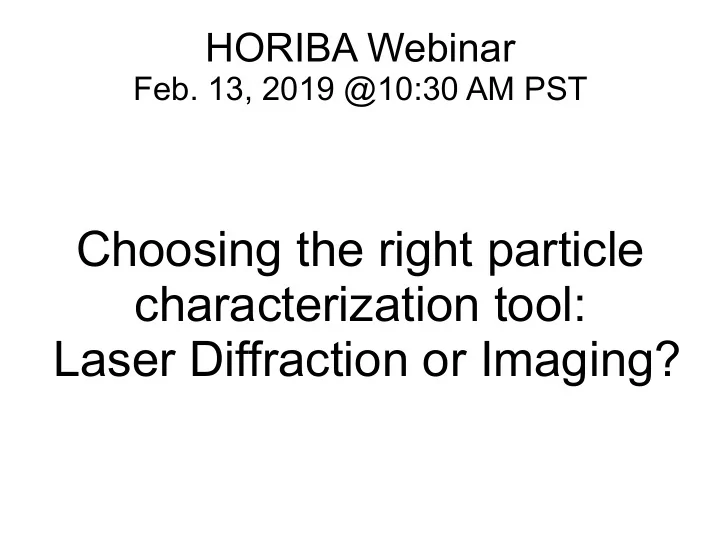

HORIBA Webinar Feb. 13, 2019 @10:30 AM PST Choosing the right particle characterization tool: Laser Diffraction or Imaging?
Customer perspectives ● “I need to measure my particles. What technique should I choose?” ● “I think I know what I need, I'm but curious to see if there are more suitable alternatives” ● “I know exactly what I want to measure and the best instrument for my application, can I have a quote please?”
Vendor perspectives ● “Where will the instrument be used?” ● “What particle parameters do you want to measure?” ● “What particle size range do you need to cover for your applications?” ● “Do you need to measure particle shape?” ● “Do you need to be able to compare data with other depts/sites?” ● “How much budget do you have?”
What you will learn today ● Basic principles of laser diffraction and imaging techniques ● Key information these techniques can provide ● Typical applications where they are used ● Guidelines for choosing between the two techniques ● Application examples ● Overview of instrumentation offered by HORIBA
Techniques - Particle size range Laser Diffraction Imaging Dynamic/Static
Laser Diffraction – How It works
Laser Diffraction – What it measures MIE Theory Intensity vs. Angle => Particle size distribution • Sphere equivalent diameter • Volume weighted distribution • Cumulative response of all particles in beam • Does not measure individual particles
LD – Key Strengths/Limitations Strengths • Wide dynamic range - sub micron to millimetre • Fast measurement - good statistical sampling • Very repeatable - great for bulk characterization QC • Widely used in regulated environments Limitations • Only gives sphere equivalent size • Great for milled particles but less relevant to irregular shapes e.g needles • No individual particle data
Laser Diffraction – Typical Applications Incoming raw material QC • Pharmaceutical ingredients Product/process development labs • Rapid characterisation/prototyping Troubleshooting in central lab facility • Comparison of production sites Outbound product QC and monitoring • Customer satisfaction, regulation etc.
Imaging – How It works
Imaging – Dynamic vs Static Dynamic Static
Imaging – Size range per lens
Imaging – What it measures Digital 2D image of individual particles Particle size Length, Width, Circle equivalent diameter Particle shape • Sphericity, elongation, roughness etc. Number/frequency weighted distributions
Imaging – Key strengths/limitations Strengths • More complete characterisation of size and shape for irregular particles • Individual images - information rich • Orthogonal technique for validation of LD Limitations • More care with sample dispersion required • Data interpretation can be more complex • Limited resolution sub-micron
Imaging – Typical applications Quality control Applications where particle shape is important Additional visual proof required - qualitative Research and development Quick “look see” characterization type measurements Validation of other methods such as LD Troubleshooting Forensic investigations, contaminants etc.
Sample dispersion
Wet vs Dry Dispersion Dry/Air Dispersion • Passive (freefall) or active (gas flow) • Convenient for non-cohesive dry powders • Not suitable for fragile cohesive materials Wet/Liquid Dispersion • Greater control over energy input - stirring, ultrasound etc. • Convenient for particles already in suspension • Particle solubility may be an issue • Image contrast issues
Number vs volume Number Volume Size Size
Diffraction/Imaging Comparison Laser Diffraction Imaging Particle size *** *** Dynamic range *** ** Particle shape *** Dry dispersion *** *** Wet dispersion *** ** Sampling/repeatability *** ** Individual particle data/images ***
Guidelines for choosing ● Particle size range ● Degree of polydispersity ● Dispersion method ● Non-spherical particles? ● Is particle shape important? ● Routine QC or research/forensic tool? ● Comparing/collaborating with data? ● Regulated environment?
Application example 1 Stainless Steel Powder for 3D printing Formed by gas atomisation => Spherical particles PSD determines packing density and uniformity Mechanical strength and surface properties Suitable for dry dispersion Laser diffraction Dynamic Imaging
Application example 1 Stainless Steel Powder for 3D Printing Dynamic Image Analysis (DIA) Laser Diffraction (LD) S. Steel A S. Steel A D50 D10 D90 LD 43.1 23.4 73.6 DIA 45.0 22.8 78.9 Std Dev 1.3 0.4 3.7 C V 3 0% 1 8% 4 9%
Stainless Steel Powder B Laser Diffraction (LD) Dynamic Image Analysis (DIA) S. Steel B S. Steel B D50 D10 D90 LD 49.4 36.0 71.4 DIA 50.2 33.7 76.2 Std Dev 0.6 1.6 3.4 CoV 1.1% 4.7% 4.6%
Application example 2 Alumina powder for abrasives Hard, irregular shaped particles Size and shape => abrasive properties
Application example 2 Laser Diffraction (LD) Dynamic Image Analysis (DIA) Basic Zoom Camera Camera D50 D10 D90 LD (Dry) 97.2 71.2 135.2 LD (H 2 O) 102.4 72.4 153.2 DIA 105.7 73.5 159.3 CoV 4.2% 1.6% 8.4%
Alumina Shape Spherecity =>1 – less abrasive
Application example 3 Solubility of pharmaceutical active ingredient Efficacy of drug measured with dissolution profile Particle size distribution an important factor Smaller particles dissolve more quickly Particle shape can also be important Rough particles – higher surface area – faster dissolution
Application example 3
Complementary Tools Certain circumstances may be advantageous to use both Laser Diffraction – daily workhorse Imaging (microscope) – primary reference method Validation of Laser Diffraction methods in regulated environments e.g. Pharma
Disclaimer There is no one size fits all! If in doubt ask your vendor to measure samples with both techniques!
Dynamic Range of the HORIBA Particle Characterization Systems https://static.horiba.com/fileadmin/Horiba/Products/Scientific/Particle_Characterization/Particle_Guidebook.pdf
Contact Info Dr Carl Levoguer - Consultant Carl.levoguer@googlemail.com Julie Chen Nguyen julie.nguyen@horiba.com Product Enquiries info@horiba.com
Recommend
More recommend